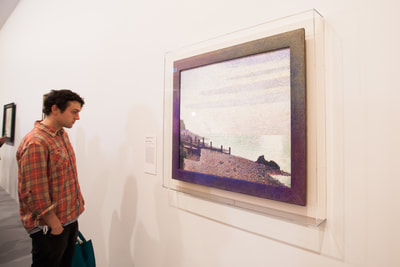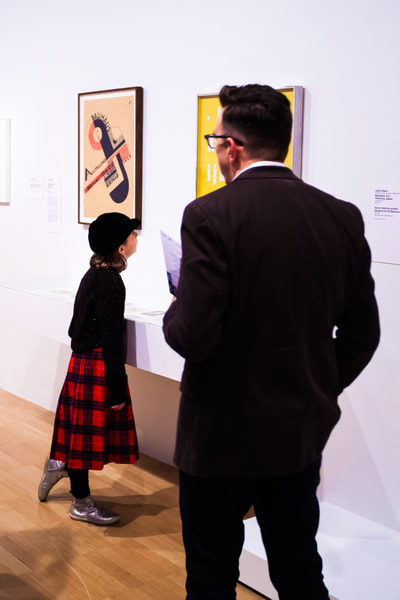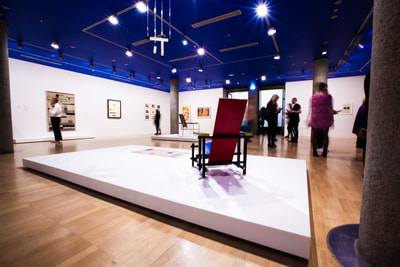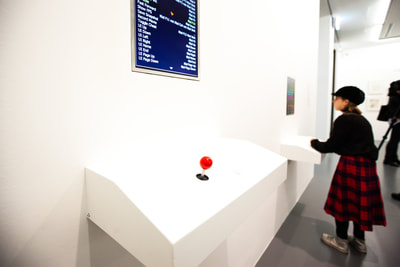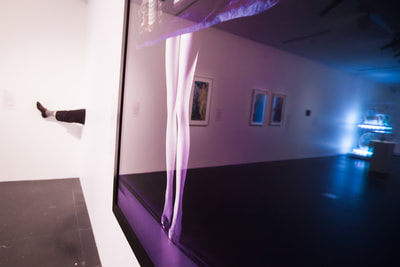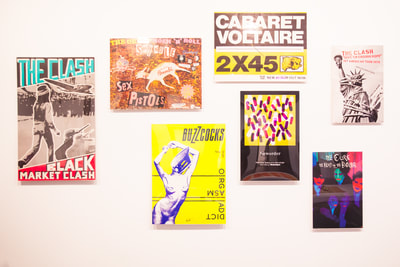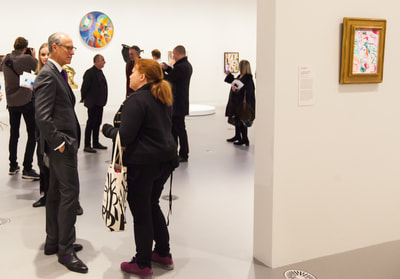We connect you with the top talents, celebrities, organsations and businesses in the world.
Happy reading!
Happy reading!
NGV: MoMA New York
website
website
photography: Erkin Kalayci at Melbourne Cheers Photography
review; Carolyne Newall
MoMA review
Several years ago, like most tourists in New York, I found myself visiting the wonderful Museum of Modern Art (MoMA). It was a short visit. At the end of a long day the many floors and abundance of magnificence, interesting and curious was overwhelming. I left saddened by the thought that I may not get to revisit and that I had missed a once in a lifetime opportunity. The idea that a sampling of MoMA’s vast collection would make its way to Australia never entered my head. The cost, the insurance, the logistics were beyond imagining.
I share this recollection to make a point. It is simply not possible to fully appreciate the importance of the current MoMA at NGV: 130 Years of Modern and Contemporary Art exhibition. To fully comprehend the privilege that is ours as we get to see works which have never before left MoMA. Almost 50% of the exhibition is work that has never left the US before. Even if you have never been to an art gallery in your life, I implore you to visit this exhibition.
To put things into context, I am not an artist, though I can paint pretty good furniture. The significance of MoMA is that its conception in 1929 came at a time when the very definition of art was changing. It was democratising. No longer was art confined only to traditional ideas of oils on canvas, rather it encompassed all areas and mediums of the modern world. Art was to be seen in the everyday – in furniture and architecture, in the mechanical and the functional, in popular culture and new media, in representations of beauty and psychology. Furthermore, art was no longer to be available only to the wealthy and the elite. The inclusion of clothing, album covers, posters, furniture, video games, emojis and mechanical elements encourage us all to see beauty in design and function.
Curating such an interdisciplinary and intertextual collection required a different set of criteria and MoMA’s almost 200,000 works are curated by department. The six departments are: Architecture and Design, Drawings and Prints, Film, Media and Performance Art, Painting and Sculpture, and Photography. That MoMA has set the precedents and international standards of modern art curation is a given. It was the first museum to recognise photography, cinema, architecture and industrial design as deserving dedicated departments that belong in an art museum.
So why would such an esteemed and important gallery pack up hundreds of millions of dollars’ worth of art and fly it almost 17,000 km to Melbourne? Glenn D. Lowry, MoMA’s sixth and current director, speaking at the launch last week, admitted to some moments of terror as he was being shown round the NGV exhibition. As he passed a Picasso, a Van Gogh and then the Kahlo he was reminded of the enormous value of these works. Make no mistake, this exhibition says a lot about the generosity of MoMA but it says even more about the high regard in which the National Gallery of Victoria (NGV) is held internationally.
Established in 1861, NGV is the oldest and most visited public art museum in Australia. It grew slowly for over one hundred years in its original location at the State Library of Victoria, until in 1968 its current and permanent home was opened at 180 St Kilda Road. The St Kilda Road Gallery is now known as NGV International and houses the gallery’s collection of international works, The Ian Potter Centre: NGV Australia, which opened in 2002 at Federation Square, is home to the Australian art collection – including works by the Aboriginal and Torres Strait Island communities. The combined NGV collection includes over 70,000 art works from across centuries and cultures. However it is not just the breadth of the collection that has brought NGV international recognition but the vitality with which the gallery engages with the people. Diverse temporary exhibitions, Collection displays, talks, tours, programs for kids, films, late-night openings and performances all aimed at making connections between the art and the people who inhabit the city.
If you don’t want to be weighed down by too much information you can skip the next couple of paragraphs.
It is fitting then that the first of the eight loosely chronological thematic sections of the MoMA at NGV: 130 Years of Modern and Contemporary Art exhibition, ‘Arcadia and Metropolis’ examines how artists at the dawn of the 20th Century responded to the rise of cities. This is followed by ‘The Machinery of the Modern World’ which highlights avant-garde movements and references MoMA’s 1934 Machine Art exhibition, while ‘A New Unity’ explores various tendencies that unified art, architecture and design within a utopian vision for the future: like the cross-media manifestations of the Russian avant-garde including some interesting posters. Next comes ‘Inner and Outer Worlds’, in which artists sought to create a visual language to represent the human psyche. ‘Art as Action’ highlights key examples of Abstract Expressionism and expands to include other forms of kineticism in the 1950s. The exhibition’s largest section, ‘Things as They Are’, encompasses the varied production of the 1960s and ’70s, from Pop art to Minimalism and Post-Minimalism, followed by ‘Immense Encyclopedia’, which explores how popular culture continued to influence art practice, contributing to a further breakdown of the traditional hierarchies of art. Changes in music, advertising and graphic design, radio and computer technologies signaled the dawn of a ‘postmodern’ era. For many artists, the mandate to be original within this context was increasingly challenging. The last section of the exhibition, ‘Flight Patterns’, shows how running parallel with increased physical mobility in the twenty-first century has been the seemingly infinite expansion of the digital universe. This endlessly diverse, mutable and fluid world is a subject of contemplation for many contemporary artists, architects and designers. Installation and performance works will also run throughout the course of the exhibition.
The list of artists who are included in the exhibition is extensive and includes the famous: Pablo Picasso, Van Gogh, Frida Kahlo, Georgia O’Keeffe, Henri Matisse and Salvador Dali and the not immediately known to me: Louise Bourgeois, Jeff Koons, Cindy Sherman to Al Loving, El Anatsui and Camille Henrot.
There are more than 230 works in the exhibition, of which 200 have never been to Australia before, which is the largest instalment of the Melbourne Winter Masterpieces exhibition series to date, for the first time encompassing the entire ground floor of NGV International. It represents more than 130 years of radical artistic innovation and reflects the wider technological, social and political developments that transformed society during this period, from late nineteenth century urban and industrial transformation, through to the digital and global present.
As befits the normal practice of the NGV I was impressed by the addition of ‘For Kids’ plates attached under many of the works which gave explanations and details aimed at children. But that paled when we discovered the pulsing light and colour of the special hands on kids zone. Very cool. What was extra cool was going through the exhibition at the same time as a young family. The two older children, who were still very little, were obviously captivated by some of the exhibits and watching them engage and enjoy was lovely.
An extensive range of programs will be running in the city for the duration of the exhibition. MEL&NYC is a city-wide cultural festival throughout Melbourne from June to October that celebrates the cultural connections between Melbourne and New York City. Simone Forti’s seminal performance piece Huddle, 1961, will be performed in Federation Court throughout. New York City is the centre of New York! New York!, a playful and interactive new exhibition for children and families. New York! New York! gives children the opportunity to learn about New York City – the cultural metropolis that has inspired many renowned artists. Finally, NGV FRIDAY NIGHTS, the curated program reflects a varied range of musical experiences and draws inspiration from the home of jazz, New York City, with rhythmic stylings including the Great American Songbook, neo-soul, gospel, jazz-blues, hip-hop and funk. Headlining this special event is Brooklyn-based, contemporary jazz trumpeter Maurice ‘Mobetta’ Brown whose hip-hop/funk combo has seen him record with leading artists including Florence and the Machine, Wyclef Jean, Macy Gray and The Roots.
Like most of us I am guilty of occasional grumbling about our government and I am sure I was not the only one who was surprised when MoMA Director Glenn D. Lowry told NGV Director Tony Elwood that he had a little government envy. According to Lowry it was unheard of that any US government would invest as generously in the arts as the Victorian and Australian governments have. As I mentioned in the beginning, this would have been prohibitively expensive. I have long claimed that beautiful men are like great art, wonderful to look at but you don’t want to take them home because the insurance and maintenance costs are massive. It is fortunate for us that the Australian government has an insurance program to provide funding for the purchase of insurance for significant cultural exhibitions, without it the high cost of commercial insurance would have made this exhibition impossible.
The support of the Victorian government to the NGV has been consistent through a number of administrations and the current one is no exception. Martin Foley is my local member and apart from his position as Minister for Creative Industries he is also Minister for Housing. I have met him in both capacities and I can say in absolute honesty that he is strongly committed to and works hard for both.
NGV also has a solid list of sponsors and supporters in the corporate worlds and the shinning black Mercedes sports car in the forecourt gave the nod to a major one. Horst von Sanden,
CEO & Managing Director Mercedes-Benz Cars Australia Pacific Pty Ltd, said that ‘engaging with truly visionary work and ideas is crucial to Mercedes-Benz’s position as a leading automotive designer and producer.’ It is for this reason that they have had a longstanding partnership with NGV.
Whether you see yourself as an artist, or like me your appreciation of paintings and art are dependent on the colours used, you need to get to along to the NGV and explore this eclectic exhibition. Seriously, we are so fortunate at the NGV, it is so spacious and well laid out that you never feel you can’t get access to the art. As someone who has stood in a long line for a glimpse of Michelangelo’s David, or strained to see Van Goh’s Irises over a crowd standing eight deep, being able to stand or sit quietly in one spot and gaze at a piece of art is precious.
MoMA at NGV will be on display at NGV International from 9 June 2018 – 7 October 2018. Tickets and information are available via the NGV website: NGV.MELBOURNE
Member $23 | Adult $28 | Concession $24.50 |
Child (5–15 years) $10 | Family (2 adults + 3 children) $65.
Carolyn Newall
10/06/18
Several years ago, like most tourists in New York, I found myself visiting the wonderful Museum of Modern Art (MoMA). It was a short visit. At the end of a long day the many floors and abundance of magnificence, interesting and curious was overwhelming. I left saddened by the thought that I may not get to revisit and that I had missed a once in a lifetime opportunity. The idea that a sampling of MoMA’s vast collection would make its way to Australia never entered my head. The cost, the insurance, the logistics were beyond imagining.
I share this recollection to make a point. It is simply not possible to fully appreciate the importance of the current MoMA at NGV: 130 Years of Modern and Contemporary Art exhibition. To fully comprehend the privilege that is ours as we get to see works which have never before left MoMA. Almost 50% of the exhibition is work that has never left the US before. Even if you have never been to an art gallery in your life, I implore you to visit this exhibition.
To put things into context, I am not an artist, though I can paint pretty good furniture. The significance of MoMA is that its conception in 1929 came at a time when the very definition of art was changing. It was democratising. No longer was art confined only to traditional ideas of oils on canvas, rather it encompassed all areas and mediums of the modern world. Art was to be seen in the everyday – in furniture and architecture, in the mechanical and the functional, in popular culture and new media, in representations of beauty and psychology. Furthermore, art was no longer to be available only to the wealthy and the elite. The inclusion of clothing, album covers, posters, furniture, video games, emojis and mechanical elements encourage us all to see beauty in design and function.
Curating such an interdisciplinary and intertextual collection required a different set of criteria and MoMA’s almost 200,000 works are curated by department. The six departments are: Architecture and Design, Drawings and Prints, Film, Media and Performance Art, Painting and Sculpture, and Photography. That MoMA has set the precedents and international standards of modern art curation is a given. It was the first museum to recognise photography, cinema, architecture and industrial design as deserving dedicated departments that belong in an art museum.
So why would such an esteemed and important gallery pack up hundreds of millions of dollars’ worth of art and fly it almost 17,000 km to Melbourne? Glenn D. Lowry, MoMA’s sixth and current director, speaking at the launch last week, admitted to some moments of terror as he was being shown round the NGV exhibition. As he passed a Picasso, a Van Gogh and then the Kahlo he was reminded of the enormous value of these works. Make no mistake, this exhibition says a lot about the generosity of MoMA but it says even more about the high regard in which the National Gallery of Victoria (NGV) is held internationally.
Established in 1861, NGV is the oldest and most visited public art museum in Australia. It grew slowly for over one hundred years in its original location at the State Library of Victoria, until in 1968 its current and permanent home was opened at 180 St Kilda Road. The St Kilda Road Gallery is now known as NGV International and houses the gallery’s collection of international works, The Ian Potter Centre: NGV Australia, which opened in 2002 at Federation Square, is home to the Australian art collection – including works by the Aboriginal and Torres Strait Island communities. The combined NGV collection includes over 70,000 art works from across centuries and cultures. However it is not just the breadth of the collection that has brought NGV international recognition but the vitality with which the gallery engages with the people. Diverse temporary exhibitions, Collection displays, talks, tours, programs for kids, films, late-night openings and performances all aimed at making connections between the art and the people who inhabit the city.
If you don’t want to be weighed down by too much information you can skip the next couple of paragraphs.
It is fitting then that the first of the eight loosely chronological thematic sections of the MoMA at NGV: 130 Years of Modern and Contemporary Art exhibition, ‘Arcadia and Metropolis’ examines how artists at the dawn of the 20th Century responded to the rise of cities. This is followed by ‘The Machinery of the Modern World’ which highlights avant-garde movements and references MoMA’s 1934 Machine Art exhibition, while ‘A New Unity’ explores various tendencies that unified art, architecture and design within a utopian vision for the future: like the cross-media manifestations of the Russian avant-garde including some interesting posters. Next comes ‘Inner and Outer Worlds’, in which artists sought to create a visual language to represent the human psyche. ‘Art as Action’ highlights key examples of Abstract Expressionism and expands to include other forms of kineticism in the 1950s. The exhibition’s largest section, ‘Things as They Are’, encompasses the varied production of the 1960s and ’70s, from Pop art to Minimalism and Post-Minimalism, followed by ‘Immense Encyclopedia’, which explores how popular culture continued to influence art practice, contributing to a further breakdown of the traditional hierarchies of art. Changes in music, advertising and graphic design, radio and computer technologies signaled the dawn of a ‘postmodern’ era. For many artists, the mandate to be original within this context was increasingly challenging. The last section of the exhibition, ‘Flight Patterns’, shows how running parallel with increased physical mobility in the twenty-first century has been the seemingly infinite expansion of the digital universe. This endlessly diverse, mutable and fluid world is a subject of contemplation for many contemporary artists, architects and designers. Installation and performance works will also run throughout the course of the exhibition.
The list of artists who are included in the exhibition is extensive and includes the famous: Pablo Picasso, Van Gogh, Frida Kahlo, Georgia O’Keeffe, Henri Matisse and Salvador Dali and the not immediately known to me: Louise Bourgeois, Jeff Koons, Cindy Sherman to Al Loving, El Anatsui and Camille Henrot.
There are more than 230 works in the exhibition, of which 200 have never been to Australia before, which is the largest instalment of the Melbourne Winter Masterpieces exhibition series to date, for the first time encompassing the entire ground floor of NGV International. It represents more than 130 years of radical artistic innovation and reflects the wider technological, social and political developments that transformed society during this period, from late nineteenth century urban and industrial transformation, through to the digital and global present.
As befits the normal practice of the NGV I was impressed by the addition of ‘For Kids’ plates attached under many of the works which gave explanations and details aimed at children. But that paled when we discovered the pulsing light and colour of the special hands on kids zone. Very cool. What was extra cool was going through the exhibition at the same time as a young family. The two older children, who were still very little, were obviously captivated by some of the exhibits and watching them engage and enjoy was lovely.
An extensive range of programs will be running in the city for the duration of the exhibition. MEL&NYC is a city-wide cultural festival throughout Melbourne from June to October that celebrates the cultural connections between Melbourne and New York City. Simone Forti’s seminal performance piece Huddle, 1961, will be performed in Federation Court throughout. New York City is the centre of New York! New York!, a playful and interactive new exhibition for children and families. New York! New York! gives children the opportunity to learn about New York City – the cultural metropolis that has inspired many renowned artists. Finally, NGV FRIDAY NIGHTS, the curated program reflects a varied range of musical experiences and draws inspiration from the home of jazz, New York City, with rhythmic stylings including the Great American Songbook, neo-soul, gospel, jazz-blues, hip-hop and funk. Headlining this special event is Brooklyn-based, contemporary jazz trumpeter Maurice ‘Mobetta’ Brown whose hip-hop/funk combo has seen him record with leading artists including Florence and the Machine, Wyclef Jean, Macy Gray and The Roots.
Like most of us I am guilty of occasional grumbling about our government and I am sure I was not the only one who was surprised when MoMA Director Glenn D. Lowry told NGV Director Tony Elwood that he had a little government envy. According to Lowry it was unheard of that any US government would invest as generously in the arts as the Victorian and Australian governments have. As I mentioned in the beginning, this would have been prohibitively expensive. I have long claimed that beautiful men are like great art, wonderful to look at but you don’t want to take them home because the insurance and maintenance costs are massive. It is fortunate for us that the Australian government has an insurance program to provide funding for the purchase of insurance for significant cultural exhibitions, without it the high cost of commercial insurance would have made this exhibition impossible.
The support of the Victorian government to the NGV has been consistent through a number of administrations and the current one is no exception. Martin Foley is my local member and apart from his position as Minister for Creative Industries he is also Minister for Housing. I have met him in both capacities and I can say in absolute honesty that he is strongly committed to and works hard for both.
NGV also has a solid list of sponsors and supporters in the corporate worlds and the shinning black Mercedes sports car in the forecourt gave the nod to a major one. Horst von Sanden,
CEO & Managing Director Mercedes-Benz Cars Australia Pacific Pty Ltd, said that ‘engaging with truly visionary work and ideas is crucial to Mercedes-Benz’s position as a leading automotive designer and producer.’ It is for this reason that they have had a longstanding partnership with NGV.
Whether you see yourself as an artist, or like me your appreciation of paintings and art are dependent on the colours used, you need to get to along to the NGV and explore this eclectic exhibition. Seriously, we are so fortunate at the NGV, it is so spacious and well laid out that you never feel you can’t get access to the art. As someone who has stood in a long line for a glimpse of Michelangelo’s David, or strained to see Van Goh’s Irises over a crowd standing eight deep, being able to stand or sit quietly in one spot and gaze at a piece of art is precious.
MoMA at NGV will be on display at NGV International from 9 June 2018 – 7 October 2018. Tickets and information are available via the NGV website: NGV.MELBOURNE
Member $23 | Adult $28 | Concession $24.50 |
Child (5–15 years) $10 | Family (2 adults + 3 children) $65.
Carolyn Newall
10/06/18
BTS photos: Natasha Marchev
BTS photos: Rouben Dickranian:
filming and editing: Daniel Cui at DC Filming Prduction
National Gallery of Victoria presents MoMA The Museum of Modern Artcollection exposed in Melbourne this winter ; MoMA at NGV: 130 Years of Modern and Contemporary Art / MoMA at NGV (9 June - 7 October)
art photography: Erkin Kalayci at Cheers Melbourne Photography
review by Carolyn Newall,
film coverage by Daniel Cui,
Sonal Sharma interviews and
support in organising by Rouben Dickranian
interviewed: Glenn Lowry (director MoMA NY)
and Tony Ellwood (director NGV)
Bohemian Rhapsody Club and Magazine expresses its special thanks to the the #NGV management, exhibition marketing and publicity team and personally to Isabella Radevski for the opportunity to cover such a marvelous event and to Erkin, Sonal, Rouben and Carolyn for their kind assistance in coverage
Exclusively for Bohemian Rhapsody Magazine
art photography: Erkin Kalayci at Cheers Melbourne Photography
review by Carolyn Newall,
film coverage by Daniel Cui,
Sonal Sharma interviews and
support in organising by Rouben Dickranian
interviewed: Glenn Lowry (director MoMA NY)
and Tony Ellwood (director NGV)
Bohemian Rhapsody Club and Magazine expresses its special thanks to the the #NGV management, exhibition marketing and publicity team and personally to Isabella Radevski for the opportunity to cover such a marvelous event and to Erkin, Sonal, Rouben and Carolyn for their kind assistance in coverage
Exclusively for Bohemian Rhapsody Magazine
|
Unique visitors:
|
|
|
|



